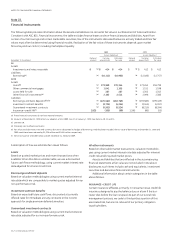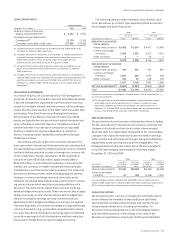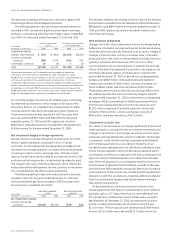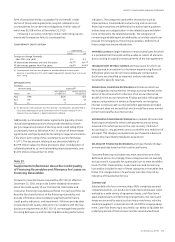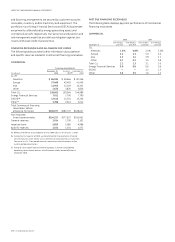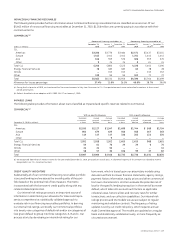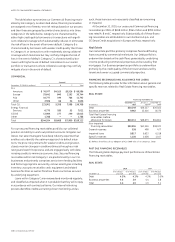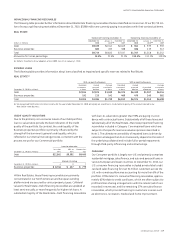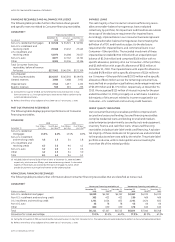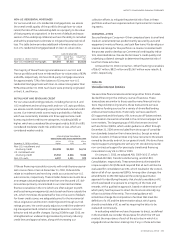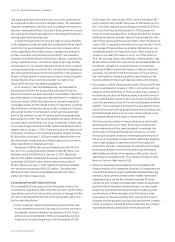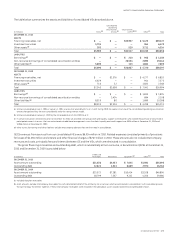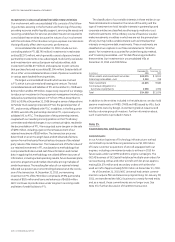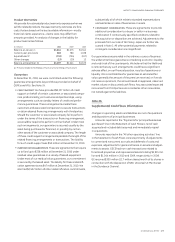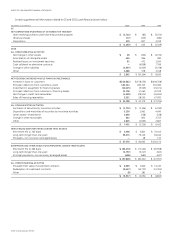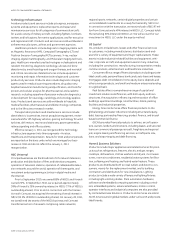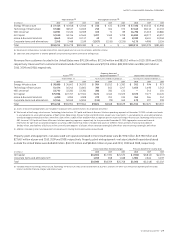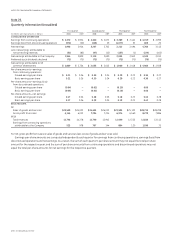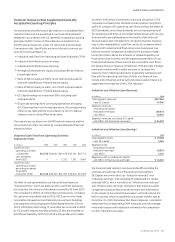GE 2010 Annual Report Download - page 124
Download and view the complete annual report
Please find page 124 of the 2010 GE annual report below. You can navigate through the pages in the report by either clicking on the pages listed below, or by using the keyword search tool below to find specific information within the annual report.122 GE 2010 ANNUAL REPORT
If the long-term credit rating of GECC were to fall below AA-/
Aa3 or its short-term credit rating were to fall below A-1+/P-1,
GECC would be required to provide approximately $1,508 mil-
lion to such entities as of December 31, 2010 pursuant to
letters of credit issued by GECC. To the extent that the entities’
liabilities exceed the ultimate value of the proceeds from the
sale of their assets and the amount drawn under the letters of
credit, GECC is required to provide such excess amount. As the
borrowings of these entities are already reflected in our con-
solidated Statement of Financial Position, there would be no
change in our debt if this were to occur. As of December 31,
2010, the carrying value of the liabilities of these entities’ was
$5,690 million and the fair value of their assets was $5,989 mil-
lion (which included net unrealized losses on investment
securities of $690 million). With respect to these investment
securities, we intend to hold them at least until such time as
their individual fair values exceed their amortized cost. We
have the ability to hold all such debt securities until maturity.
• Securitization QSPEs comprise previously off-book QSPEs that
were consolidated on January 1, 2010 in connection with our
adoption of ASU 2009-16 & 17. These entities were created to
facilitate securitization of financial assets and other forms of
asset-backed financing which serve as an alternative funding
source by providing access to the commercial paper and term
markets. The securitization transactions executed with these
entities are similar to those used by many financial institutions
and substantially all are non-recourse. We provide servicing
for substantially all of the assets in these entities.
The financing receivables in these entities have similar risks
and characteristics to our other financing receivables and
were underwritten to the same standard. Accordingly, the
performance of these assets has been similar to our other
financing receivables; however, the blended performance of
the pools of receivables in these entities reflects the eligibility
criteria that we apply to determine which receivables are
selected for transfer. Contractually the cash flows from these
financing receivables must first be used to pay third-party
debt holders as well as other expenses of the entity. Excess
cash flows are available to GE. The creditors of these entities
have no claim on other assets of GE.
• Other remaining assets and liabilities of consolidated VIEs
relate primarily to five categories of entities: (1) enterprises we
acquired that had previously created asset-backed financing
entities to fund commercial real estate, middle-market and
equipment loans; we are the collateral manager for these
entities; (2) joint ventures that lease light industrial equipment
and that hold a limited partnership interest in certain media
properties; (3) entities that have executed on-balance sheet
securitizations of financial assets and of third-party trade
receivables; (4) insurance entities that, among other lines of
business, provide property and casualty and workers’ compen-
sation coverage for GE; and (5) other entities that are involved
in power generating, leasing and real estate activities.
that significantly determine the entity’s economic performance
as compared to other economic interest holders. This evaluation
requires consideration of all facts and circumstances relevant to
decision-making that affects the entity’s future performance and
the exercise of professional judgment in deciding which decision-
making rights are most important.
In determining whether we have the right to receive benefits
or the obligation to absorb losses that could potentially be signifi-
cant to the VIE, we evaluate all of our economic interests in the
entity, regardless of form (debt, equity, management and servic-
ing fees, and other contractual arrangements). This evaluation
considers all relevant factors of the entity’s design, including: the
entity’s capital structure, contractual rights to earnings (losses),
subordination of our interests relative to those of other investors,
contingent payments, as well as other contractual arrangements
that have potential to be economically significant. The evaluation
of each of these factors in reaching a conclusion about the poten-
tial significance of our economic interests is a matter that
requires the exercise of professional judgment.
As of January 1, 2010 and subsequently, we evaluated all
entities that fall within the scope of the amended ASC 810 to
determine whether we were required to consolidate or deconsoli-
date them based on the approach described above. In addition to
the securitization QSPEs described above, we were required to
consolidate assets of VIEs related to direct investments in entities
that hold loans and fixed income securities, a media joint venture
and a small number of companies to which we have extended
loans in the ordinary course of business and have subsequently
been subject to a TDR. The incremental effect of these entities on
our total assets and liabilities, net of our investment in them, was
an increase of approximately $31,097 million and $33,042 million,
respectively, at January 1, 2010. There also was a net reduction of
total equity (including noncontrolling interests) of approximately
$1,945 million at January 1, 2010, principally related to the rever-
sal of previously recognized securitization gains as a cumulative
effect adjustment to retained earnings.
The assets of QSPEs that we consolidated were $29,792 mil-
lion, net of our existing retained interests of $8,782 million, and
liabilities were $31,616 million at January 1, 2010. Significant
assets of the QSPEs included net financing receivables and trade
receivables of $39,463 million and investment securities of
$1,015 million at January 1, 2010. Significant liabilities included
non-recourse borrowings of $36,112 million. The assets and
liabilities of other VIEs we consolidated were $1,305 million
and $1,426 million, respectively.
Consolidated Variable Interest Entities
We consolidate VIEs because we have the power to direct the
activities that significantly affect the VIEs’ economic performance,
typically because of our role as either servicer or manager for the
VIE. Our consolidated VIEs fall into three main groups, which are
further described below:
• Trinity is a group of sponsored special purpose entities that
holds investment securities, the majority of which are invest-
ment grade, and are funded by the issuance of GICs. These
entities were consolidated in 2003, and ceased issuing new
investment contracts beginning in the first quarter of 2010.


